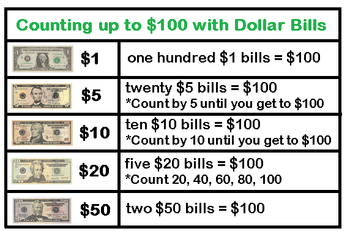Let’s try to understand money exchange and counting using mental math, and one simple question – “How many 20 make a 100?”
Quick Navigation
The Mystery of $100
Why use 100 as the pivot for money calculations? And why focus on $100 only. For starters, it’s an easy number to add up to, subtract from, and a rounded of total different permutations possible with bill exchanges.
Second reason – for smaller amounts such as $50 or even $20 and $10, calculations will become complex, and coins will be involved. Sneak peek! We will briefly visit coin calculations too, at the end of this post!
Understanding exchanges begins with understanding counting money. For instance, if you hand a $100 bill for a $40 purchase, how much money will you be handed back? The answer is $60.
Now, what bills could these be to make up $60? It could be three $20 bills, six $10 bills, twelve $5 bills, or perhaps sixty $1 bills.
But, that’s not all. You could even get $50 and $10 from the shopkeeper. Or, two $20 and two $10 bills.
What other ways can you think of for getting a $60 return in combinations of different bills? Have a look at the table below to help you add up different exchange combinations.

It isn’t that hard, is it? Let’s try to level up now.
The Danger of the Decimal
While many kids struggle with $100 exchanges, decimal numbers with money make adults sweat too.
Keep the change! Cause I can’t add up? Once you’ve explored the combination strategy with $100, the same can be applied to $1.00. Visualize it as “100” only with a decimal in between. (100-1 =99, 1.00- 0.01=0.99)
With this visual, let’s talk about how many coins add up to $1.00. Instead of dollar bills, we now have pennies, nickels, dimes, and quarters.
One dollar is four quarters. It is also 10 dimes. 20 nickels add up to a dollar, and 100 pennies too make a dollar.
This chart will help you understand these values. The rest stays the same – different combinations adding up to the same value.
Say, two quarters and five dimes? What other combinations can you think of?

Final Words
Finally, coming to the answer to the question for this post. How many 20s make a 100? With the money chart and exchange math, you’ve surely arrived at – Five!
Dividing money, word problems, decimal values for money, and all other calculations become much simpler if kids can understand counting money and the math behind the exchange. We hope this post gives you an easy explanation guide with tips and tricks along the way.

